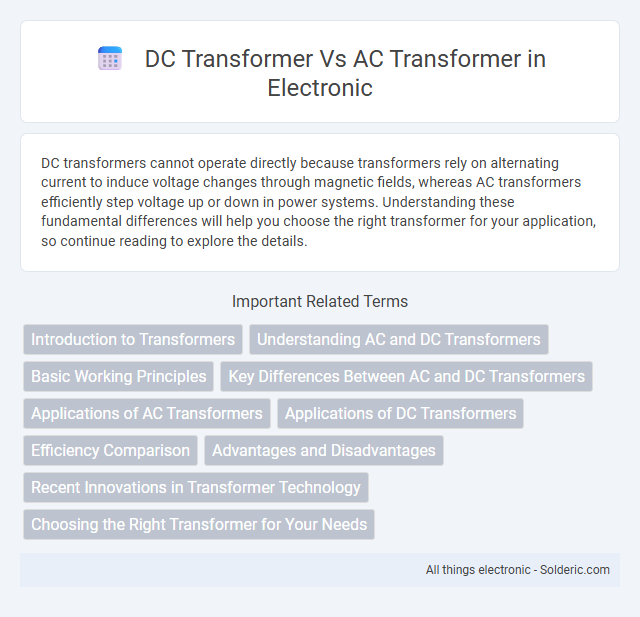DC transformers cannot operate directly because transformers rely on alternating current to induce voltage changes through magnetic fields, whereas AC transformers efficiently step voltage up or down in power systems. Understanding these fundamental differences will help you choose the right transformer for your application, so continue reading to explore the details.
Comparison Table
| Feature | DC Transformer | AC Transformer |
|---|---|---|
| Operation Principle | Uses electronic circuits to change voltage | Uses electromagnetic induction to change voltage |
| Input Type | Direct Current (DC) | Alternating Current (AC) |
| Voltage Conversion | Achieved via switching converters or choppers | Achieved via transformer coils and magnetic flux |
| Core Requirement | Not required | Magnetic core required |
| Efficiency | High, depends on electronic components | High, typically 95-99% |
| Frequency Dependence | Not frequency dependent | Depends on AC frequency |
| Size and Weight | Compact, lighter | Generally larger, heavier due to core |
| Applications | Battery chargers, DC power supplies | Power distribution, voltage regulation |
| Cost | Varies, often higher due to electronics | Generally lower for large-scale transformers |
Introduction to Transformers
Transformers are electrical devices designed to transfer electrical energy between circuits through electromagnetic induction, primarily used with alternating current (AC) to step voltage up or down efficiently. Direct current (DC) transformers do not operate because DC lacks the changing magnetic field necessary for induction, making AC transformers essential components in power distribution and electrical engineering. Understanding the fundamental differences between AC and DC transformers is crucial for optimizing energy transfer in various applications.
Understanding AC and DC Transformers
AC transformers operate by transferring alternating current through electromagnetic induction, enabling voltage changes without direct electrical connection. DC transformers, often referred to as DC-DC converters, rely on electronic circuits such as switching regulators to change voltage levels since magnetic induction does not work with steady direct current. Understanding the fundamental difference in operation highlights that AC transformers are essential for power distribution, while DC transformers are vital for electronic device power management.
Basic Working Principles
DC transformers do not function like AC transformers because they rely on electromagnetic induction, which requires a changing magnetic field produced by alternating current. AC transformers operate by passing an alternating current through the primary coil, generating a varying magnetic flux in the core, which induces a voltage in the secondary coil. The absence of a changing magnetic field in DC circuits prevents traditional transformers from stepping voltage up or down effectively.
Key Differences Between AC and DC Transformers
AC transformers rely on alternating current to induce voltage changes through electromagnetic induction, whereas DC transformers are not practical because direct current produces a constant magnetic field that does not induce voltage. AC transformers consist of primary and secondary coils wound around a magnetic core, enabling voltage transformation without energy loss through electromagnetic flux changes. DC systems use converters or choppers instead of transformers to adjust voltage levels, highlighting the fundamental difference in operation between AC and DC voltage regulation methods.
Applications of AC Transformers
AC transformers are widely used in power distribution systems to step up voltage for efficient long-distance transmission and step down voltage for safe residential and industrial use. They are essential in electrical grids, enabling the transfer of alternating current between different voltage levels while minimizing power loss. Applications also include powering household appliances, industrial machinery, and in audio systems where impedance matching is required.
Applications of DC Transformers
DC transformers are primarily used in applications requiring voltage regulation and isolation in DC circuits, such as battery charging systems, electric vehicles, and renewable energy setups like solar power inverters. Your setup benefits from DC transformers in controlling and converting direct current efficiently for stable power delivery. These transformers are essential in telecommunications, traction systems, and industrial automation where precise DC voltage transformation is needed.
Efficiency Comparison
DC transformers are inherently less efficient than AC transformers due to the need for complex power electronics to convert DC voltage levels, resulting in energy losses during the conversion process. AC transformers operate based on electromagnetic induction, providing high efficiency typically around 95-99% by minimizing resistive and core losses. The overall efficiency of DC voltage transformation depends heavily on the quality of converters and inverters, which often lowers the total system efficiency compared to traditional AC transformers.
Advantages and Disadvantages
DC transformers are generally less common due to the difficulty in stepping voltage levels directly with DC, but they provide stable and constant voltage ideal for sensitive electronic devices. AC transformers efficiently change voltage levels using electromagnetic induction, enabling long-distance power transmission with reduced energy losses. However, AC transformers produce electromagnetic interference and require maintenance of insulation and cores, while DC systems often need complex conversion equipment, increasing cost and complexity.
Recent Innovations in Transformer Technology
Recent innovations in transformer technology have focused on enhancing efficiency and reducing losses in both DC and AC transformers. Advanced materials like amorphous steel cores and nanocrystalline alloys improve magnetic properties, enabling higher performance in AC transformers, while solid-state transformer designs enable efficient DC voltage conversion with reduced size and weight. Your energy systems can benefit significantly from these developments, improving reliability and reducing operational costs.
Choosing the Right Transformer for Your Needs
Choosing the right transformer depends on whether your application requires DC or AC power, as each serves distinct functions with varying efficiency and complexity. AC transformers work by electromagnetic induction to step voltage up or down and are ideal for power distribution due to their simplicity and reliability. DC transformers require complex electronic circuits and provide stable voltage regulation crucial for sensitive electronics, making them suitable for specific industrial and electronic applications.
DC transformer vs AC transformer Infographic

 solderic.com
solderic.com